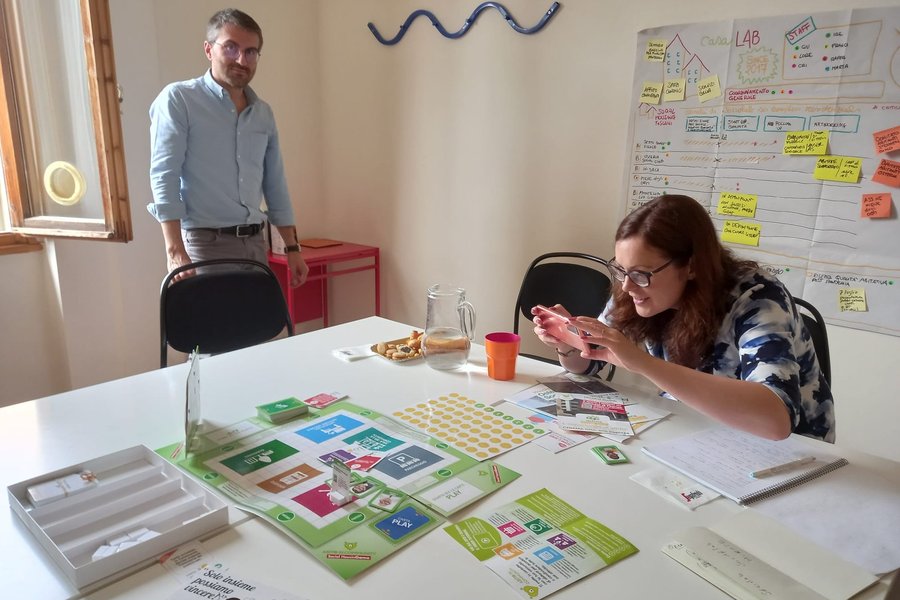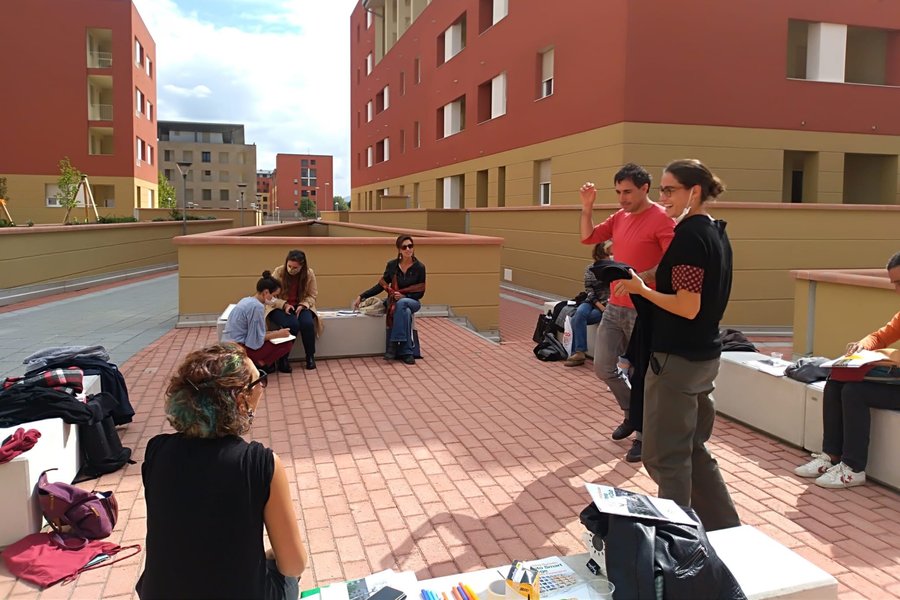Social Innovation Labs – Well-being through Collaboration and Conflict
Social Innovation labs are a relatively new phenomenon growing in popularity from about 2000 onwards (Einfield and Blomkamp 2021). They are in part a response to the growing complexity of real-world policy problems. An additional driver is a decline in the effectiveness of command-and-control management models at resolving complex policy problems. Citizens can grow distrustful when they feel talked over, or change fails to emerge. Conflict tends to be part and parcel of engagements with complex policy problems that involve multiple actors. As part of the University of Birmingham’s EUniWell Urbanity and Well-being project, I visited Sociolab - a Florence-based social innovation lab who uses the principles of human-centred design in its work on civic and social housing projects. In this blog, I reflect on how increasingly blurred lines between the spaces of the city and the home are changing how conflict emerges in real-world policy problems and I make a case for social innovation labs to be better placed to engage with this.
Sociolab – who they are and how they work
Sociolab aims to facilitate the growth of communities and organisations starting from people. The idea of human-centred process design is currently popular in social housing and city planning work but can be poorly defined. Sociolab’s expertise reflects the complexity of real-world problems. Their team of 15 staff includes anthropologists, sociologists, economists, psychologists, and a network of consultant specialists who can be called in to provide new insights. Sociolab utilises reflective practices, building into each working day a mini-lab to discuss the challenges that arise in their projects. This reflective approach engages openly with the conflict that is inevitable when working with complex policy problems (Bartels 2018). Reflective practice aids in the facilitatory approach they take when bringing together their expertise with people situated within the policy problem. To facilitate engagement with problem complexity and to constructively engage with conflict they use a range of tools including playing games and structured participation methods.
Sociolab undertakes a range of projects including research, policy design and working with the residents of new social housing initiatives in the metropolitan area of Florence and Prato to build a culture of collaboration in their approach (Promo 2022). These projects are returned to, for now, covid-induced changes to how we interact with our homes are described alongside a turn to more intimate 15-minute city design.
Blurred lines – the city as home and home as the city
During my discussion with Cristian Pardossi, Facilitator at Sociolab, and President of Sociolab, Giulia Maraviglia, Giulia describes the home as the ‘first Lego brick to quality of life in the city’. She describes how covid has blurred formerly more static demarcations between the city and home through shifting activities that would normally take place in the city, into the home. Covid focussed attention to the quality of the home, due to months of confinement within this space. Surrounding this is a turn to ‘the 15-minute city’ models an approach to thinking about Big Cities that existed before the pandemic and has gained renewed interest through the pandemic. In this approach, the idea is everything a person needs, shops, social activities, work, and study should be no more than 15 minutes away from home. In this image then of a jigsaw city, the quality of immediate neighbourhoods and home are centred. The division between the home and the city becomes more porous as what makes a place feel homely is more closely entangled with the experience of the neighbourhood. In turn for people to want to live in such intimate city jigsaw pieces, the quality of home is accentuated as it is the starting and end point of neighbourhood engagements. While the aim of these transformations are cities that enable more well-being, the transition to 15-minute neighbourhoods and the resulting production of closer encounters with other human beings can produce tensions. City-based well-being then is entangled with conflict.
Social housing in Italy and Sesto Smart Village
Social housing in Italy differs from the UK. Unlike the UK, Italy did not experience a radical reform of the housing market during the 80s and 90s. Italy has consistently had one of the highest percentages of home ownership in Europe and a static rental market. Social housing in Italy has grown in the “grey area” between public state-provided housing and home ownership (Euricse 2011). Social housing caters for those who do not qualify for public housing and struggle to access the private housing market. It is a diverse space where the idea of social housing is entangled with ideas of innovation and social action. Organisations in the social housing space include co-operatives, private companies, and social enterprises. Sesto Smart Village is a large urban redevelopment project with purpose-build outdoor common areas with environmentally friendly technologies as part of the building design. The village aims to run as a collaborative community. It is the transition to collaborative management that is facilitated through the work of Sociolab.
Sesto Smart Village is an interesting place to explore the changing relationship between home and neighbourhood and where human-centred approaches fit in with this. Sesto is designed with indoor and outdoor spaces where the use is determined through collaborative approaches with the residents. The village management is transitioning away from Sociolab facilitation and towards being led by an elected resident committee. The residents of Sesto are hugely diverse and include general needs tenants, fragile families, young people in care, and other transitional and supported housing paths. That this diverse community of residents living within the context of a village design scheme are invested in their community and live together peacefully is a credit to the residents and the work of a network of third sector actors including Sociolab, the property owners, management companies and the local authorities.
The residents show me their library. This library is in part a political project. For the residents, the local municipality-run library is too far away. Thanks to a donation of high-quality books and artwork through a bequest, the residents’ library is a space where study, thinking and discussion are encouraged. By providing this quality space, the residents are making a case to local government that the Sesto library can be an extension of the municipality library. The community spaces at the village provide an opportunity for the municipality library to host education and entertainment events at the heart of the Sesto Village, bringing distanced cultural resources to the neighbourhood. There are other examples of successful collaboration. Dance and photography classes run through the skills share initiative. There are dedicated spaces for children to play. There is one space that is producing conflict that is different to that experienced before by Sociolab – the mini-allotment spaces.
How conflict is inevitable and made more complicated in intimate neighbourhoods
Through my time as a social housing practitioner, I am familiar with the conflict that Giulia describes to me. It takes on the familiar shape of an emerging problem with a design, in this case, there are too few mini-allotment spaces to meet the demand from residents. This has produced a range of different views as to what should be done with these spaces. WhatsApp groups are producing polarised views and arguments, keeping out of sight the conflict that Sociolab usually engages with through collective facilitatory tools. The transition to resident-led management and the withdrawal of Sociolab is changing the power dynamic. The tension between the experts of Sociolab and the residents, is turning to interpersonal resident-to-resident conflict. Giulia describes how this type of conflict is new to Sociolab. Sociolab is experienced in engaging in a conflict within design processes. Conflict in these contexts expands and then contracts as the design is made more concrete. In intimate neighbourhoods, conflict is less structured. Neighbourhoods are never finished products. They have tides and currents that produce storms and periods of calm. They have material snagging points, in this case the lack of allotment space, in other neighbourhoods it will be something else, the location of trees, parking spaces, all sorts of unintended consequences of design. Add to these the shifting networks of residents and their relationships to each other and the neighbourhood space and it becomes clear why conflict is more tidal in intimate neighbourhoods even as such neighbourhoods produce better well-being outcomes.
Lessons for the city
In a move to a 15-minute jigsaw city the nature of conflict changes, becoming less predictable. City planners may benefit from involving innovation labs at the design stage of material changes to neighbourhoods. Traditional participation methods in the context of command-and-control organisations will fail to engage with ideas of conflict from the start, seeking instead citizen consent for pre-designed proposals. Using innovative ways to engage in redesign and accepting that conflict is inevitable from the outset may produce design that produces less conflict in the later stages where citizens are left to live with the consequences.
In regards of conflict in intimate neighbourhoods such as Sesto, it may help to approach such conflict as an inevitable part of neighbourhood-based well-being. The difference may lie in whether these conflicts bubble away submerged on social media or in networks disconnected from the wider community. Or whether they emerge on the surface where conflicts can be engaged with, and hard decisions made. This understanding of well-being further emphasises conflict to be inevitable and the need for transparent and open processes that engage with this. Sociolab and the residents of Sesto Smart Village are in a good position to engage with tides of conflict while enjoying the calmer seas of well-being that emerges from their hard work.
Bibliography
- Bartels, K. (2018). "Collaborative dynamics in street level work: Working in and with communities to improve relationships and reduce deprivation." Environment and Planning C: Politics and Space 0(0): 1-19.
- Einfield, C. and E. Blomkamp (2021). "Nudge and co-design: complementary or contradictory approaches to policy innovation?" Policy Studies.
- Euricse. (2011). "Social Housing in Italy: outlines of innovation." Retrieved 20 June, 2022.
- Promo, U. (2022). "ABITO IN COMMUNITY, A COOPERATIVE WAY TO DO THE RIGHT HOME!" Retrieved 20 June, 2022.
Stay in touch & up-to-date!
Follow us on our social media channels:
Twitter
LinkedIn
Instagram
Facebook
And subscribe to our EUniWell newsletter for regular highlights and save-the-dates to upcoming EUniWell events delivered straight to your inbox:


